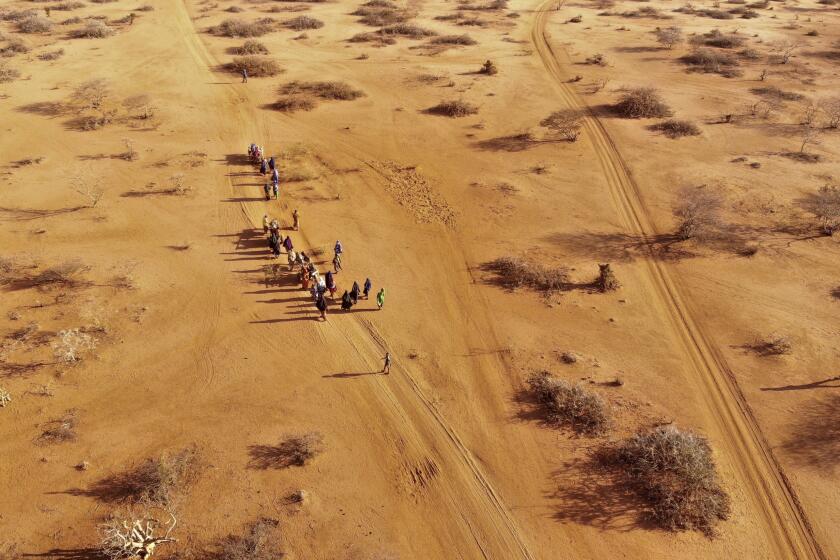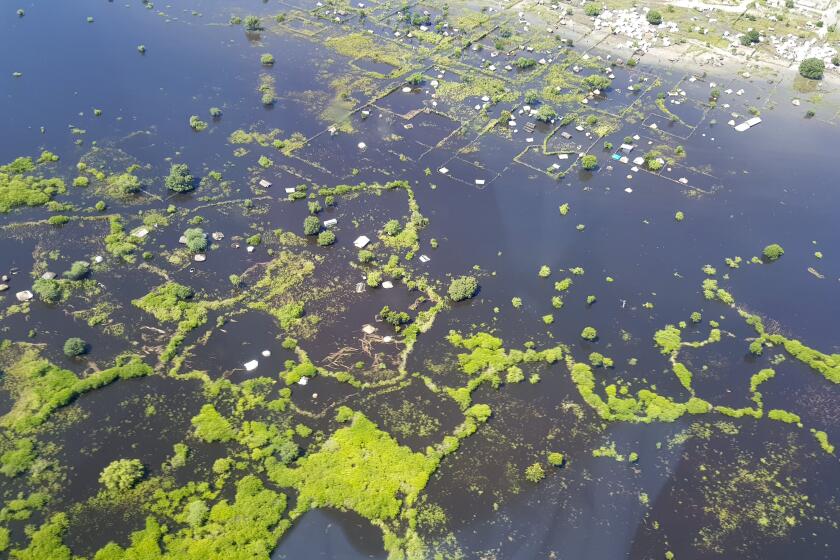Flooding worsened by El Niño sends Somalia into a state of emergency

- Share via
MOGADISHU, Somalia — First, some families fled drought and violence. Now they say they have nowhere to hide from intense flooding as rainfall exacerbated by the weather phenomenon El Niño pummels large parts of Somalia.
Floods have killed at least 96 people, the country’s Council of Ministers said Thursday.
Among the worst-hit cities is densely populated Beledweyne, where the Shabelle River has burst its banks, destroying many homes and forcing thousands to flee to higher ground near the border with Ethiopia.
Hakima Mohamud Hareed, a mother of four, including one who is disabled, said her family is constantly looking for shelter.
The family only recently moved to Beledweyne, fleeing battles between the extremist group Shabab and Somali government forces. “We left our home in search of safety and stability, but little did we know that we would end up facing another calamity,” she said by phone.
Heavy rains in Kenya, Somalia and Ethiopia triggered what aid agencies described as flooding seen only once every 100 years.
In the displacement camp of Kutiimo in Beledweyne, the floods destroyed the family’s small, tattered tent. Wind lashes the damp and flimsy fabric.
“The floods washed away all our belongings, so we were left only with our lives,” she said. “It was a traumatic experience for all of us.”
According to the humanitarian group Save the Children, the flooding has forced an estimated 250,000 people, or 90% of Beledweyne’s population, out of their homes.
Somalia’s federal government declared a state of emergency in October after extreme weather exacerbated by El Niño destroyed homes, roads and bridges.
El Niño is a natural, temporary and occasional warming of part of the Pacific that shifts weather patterns across the globe, often by moving the airborne paths for storms. It hits hardest in December through February. Scientists believe climate change is making the current El Niño stronger.
Many parts of Somalia, as well as in neighboring Horn of Africa nations Kenya and Ethiopia, are still receiving torrential rainfall in what aid agencies have described as a rare flooding phenomenon.
A United Nations report says 43,000 people died amid the longest drought on record in Somalia last year, half of whom were probably children.
The United Nations-backed Somali Water and Land Information Management project has warned of “a flood event of a magnitude statistically likely only once in 100 years,” the U.N. food agency said in a recent statement. Some 1.6 million people in Somalia could be affected by flooding in the rainy season lasting until December, it said.
Beledweyne, in the central region of Hiran, may be the most devastated community. As floodwaters swept through, homes were washed away.
Hakima said her family may be safe from flooding in their camp, but they are hungry and desperate for warm shelter.
“We ask our Somali brothers and sisters to help us get out of this situation, as we are struggling to survive,” she said.
Flooding in East Africa affects more than 1 million people, and a tropical storm threatens to make an already dire situation worse.
Mukhtar Moalim, the owner of a retail shop, described frantic attempts to save his property in Beledweyne’s market after the river burst its banks. He and a relative swam toward the shop to try to prevent the water from flowing in, putting concrete blocks against the door.
But the water level keeps rising, also threatening their residence on the floor above the shop from which they monitor the destruction.
At least 53 people have been confirmed killed by flooding across Somalia, said Hassan Isse, who manages emergency operations at the Somalia Disaster Management Agency.
“The situation is grave, and we are doing our best to provide relief to the affected people,” he said.
Mogadishu, the Somali capital, has also been affected. The city’s main streets, including the road to the airport, have flooded.
Speaking on Wednesday in the Dollow district of the Gedo region, where many families have been displaced by flooding, Prime Minister Hamza Abdi Barre urged the international community to help.
“We are doing our best, but we need more support,” he said.
More to Read
Sign up for Essential California
The most important California stories and recommendations in your inbox every morning.
You may occasionally receive promotional content from the Los Angeles Times.















